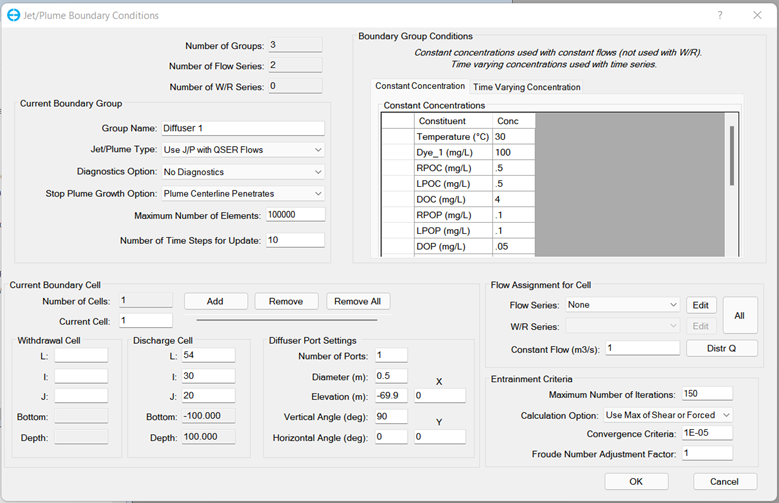Simulation of jets and plumes is an essential aspect of computational fluid dynamics. Jet and plume modeling is required in many natural and industrial applications, including wastewater outfalls and thermal discharges from power plants. This blog briefly outlines the differences between jets and plumes and looks at some of the applications of jet and plume simulations. Finally, we will examine some upcoming enhanced capabilities of EFDC+ for this purpose. A future blog will describe the validation of these enhancements.
Applications
Jets and plumes are differentiated in that a jet is a turbulent shear flow driven by momentum effects, whereas a plume (or column) is caused by buoyancy effects. The nature and strength of the source flow, as well as the receiving environment, impact the mixing. This means that the mixing and dispersion of the contaminants within the environment will depend on the momentum and buoyancy flux of the discharge as well as the ambient hydrodynamic conditions.
Research into the simulation of jets and plumes has been motivated by environmental problems such as disposal of waste and toxic materials into the environment as effluent discharge into rivers, lakes, and oceans. The submarine outfall of waste is a common disposal method and has potentially significant environmental consequences if not well designed.
In the USA, the Clean Water Act prohibits anybody from discharging pollutants through a point source into a water body unless they have a National Pollutant Discharge Elimination System (NPDES) permit. This regulates industrial and municipal wastewater, thermal discharges from once-through cooling of power plants, as well as stormwater, and many other discharges. Permits are required for most situations, including thermal discharge from power plants. The permitting process often requires simulations that track the path of near-field and far-field plumes of conservative or non-conservative contaminants. Tools such as EEMS allow the prediction and visualization of plume concentrations and their distribution in the environment.
Implementation and Enhancements in EEMS
The original calculation procedure of the jet/plume submodel in EFDC+ is mainly based on work performed by Lee and Cheung (1990). The trajectory of the plume is traced in time using a Lagrangian formulation. A plume gains mass as ambient fluid is entrained and mixed into the plume, changing the plume’s speed and density. At some point, the plume’s density may become indistinguishable from the surrounding waters and stops plume growth (i.e., neutral buoyancy condition). The plume is then distributed into the water column for far-field fate and transport. Section 2.7 of the EFDC+ Theory Document provides greater detail on this formulation.

In earlier versions of EEMS, water quality constituents were not handled by the jet/plume boundary. Resolving this issue is one of the key aspects of our latest updates. EEMS has now been enhanced to allow time-varying and constant concentrations of all simulated constituents in the jet/plume boundary condition. In addition, we have also improved the plume calculations in EFDC+, allowing for more control of the plume entrainment criteria and plume growth. Plume growth will always stop if the “Maximum Number of Elements” is exceeded before the plume stops due to reaching the neutral buoyancy level or the plume reaches to surface (plume density less than ambient) or the bottom (plume density greater than ambient). We have also improved the EE user interface by separating entrainment criteria from the plume growth criteria as shown in Figure 1.
We are excited to bring these new features and hope that they will prove helpful to our clients, customers, and the research community.
Stay tuned for our subsequent blog post that will detail the validation testing that has been performed on the EFDC+ code and demonstrate how it compares to other mixing simulation tools such as CORMIX (Doneker et al., 2007).
References
Lee, J. H. W., and V. Cheung (1990), Generalized Lagrangian model for buoyant jets in current, J. Environ. Eng., 116(6), 1085– 1106, doi:10.1061/(ASCE)0733-9372(1990)116:6(1085).
Doneker, R.L. and G.H. Jirka, “CORMIX User Manual: A Hydrodynamic Mixing Zone Model and Decision Support System for Pollutant Discharges into Surface Waters,” EPA-823-K-07-001, Dec. 2007.


